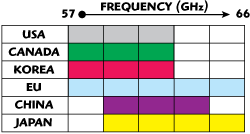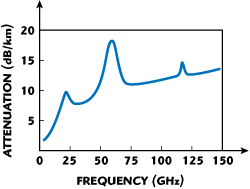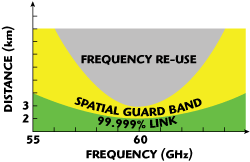The ever-increasing demand for high capacity data communication, in particular last mile communication, is asking serious questions of operators and the technology they employ. Radio bands allocated for data communication have restrictions and are, with few exceptions, subject to a national license. These licenses are in high demand, expensive and their attainment can often require a lot of paperwork and be subject to bureaucracy.
License-free bands, such as the 2.4 and 5 GHz bands, see WLAN (IEEE 802.11 a/b/g/n) and PAN (Bluetooth) competing for the allocated bandwidth and neither Quality of Service (QoS) nor security can be guaranteed in this congested environment. All parties are on the same frequency band and are relying on Carrier Sense Multiple Access with Collision Avoidance (CSMA/CA). Many applications demand communication links to have a combination of high speed and security, while also being license-free and inexpensive with instant set up. All of this cannot be achieved via traditional wireless license exempt bands.
LICENSE-FREE V-BAND
There is a band that is just coming on stream that can meet all of these requirements – namely the worldwide license-free V-band at 60 GHz. Radios operating in this 60 GHz band have unique characteristics that make them significantly different from radios operating in the traditional 2.4 and 5 GHz license free bands. These qualities give 60 GHz millimeter-wave band radios operational advantages not found in other wireless systems.
This article provides an overview of these advantages and argues why 60 GHz millimeter-wave radio technology presents the optimal opportunity, which translates into reliable and affordable gigabit-plus wireless connections. The main advantages are:
- Spectral availability to achieve gigabit-plus data rates
- High transmit power for solid signal strength and range
- Worldwide availability and acceptance
- License exempt operation
- Narrow beamwidth and oxygen absorption for interference immunity and highly secure operation.
SHANNON’S LAW
Large bandwidth coupled to high transmit power equals high data rates. Sufficient spectrum has been allocated in the 60 GHz band to make multi-gigabit wireless links possible. In the US, the Federal Communications Commission (FCC) set aside a block of 7 GHz of license exempt spectrum between 57 and 64 GHz. The majority of the globe has done the same at varying points between 57 and 66 GHz.
Partly because of oxygen’s absorption characteristics at 60 GHz, various regulators across Asia, Europe and the Americas allow for 10s to 100s of Watts of Equivalent Isotropic Radiated Power (EIRP) for wireless transmissions in this band. The wide bandwidth and high transmit power facilitate multi-gigabit wireless transmissions.
Shannon’s Law states that the maximum possible data rate is given by:
Shannon Capacity = (Channel Bandwidth) [log(Power/Noise)]. Put simply, the maximum possible data rate increases with increasing channel bandwidth and effective transmit power. So, the 60 GHz band is capable of achieving 80 times the maximum possible data rate of the 802.11a/b/g/n MAC layer.
WORLDWIDE AVAILABILITY

Figure 1 The 60 MHz frequency allocation in various countries/regions worldwide.
As previously stated, the majority of the globe has allocated 7 GHz of continuous unlicensed spectrum at varying points between 57 and 66 GHz. Figure 1 shows the 60 GHz frequency allocation in various countries/regions worldwide. Within these points, the countries have 5 GHz of continuous spectrum in common. Therefore, products that operate in this frequency will not encounter regulatory problems from country to country.
A major factor, which has commercial ramifications, is that the spectrum is unlicensed. Therefore, 60 GHz links can be deployed without expensive permits, paperwork, public notices or license fees. This makes it easier for companies to launch worldwide products requiring minimal homologation. All of these factors allow companies to maintain operational efficiencies while delivering high performance wireless products.
INTERFERENCE-FREE AND SECURE
Let’s consider the technology – oxygen attenuates 60 GHz signals that travel over large distances, meaning that oxygen absorbs radio emissions – a property that is unique to the 60 GHz spectrum. This absorption weakens the 60 GHz signals over distance, so that signals cannot travel far beyond their intended recipient. While this limits distances that they can cover, it also offers interference and security advantages when compared to other wireless technologies.
Another consequence of oxygen absorption is that radiation from one particular 60 GHz radio link is quickly reduced to a level that will not interfere with other 60 GHz links operating in the vicinity. This reduction offers the opportunity for more 60 GHz radio enabled devices to successfully operate within one location.
Frequency re-use

Figure 2 Attenuation behavior for 60 GHz signals.
The particular attenuation behavior for 60 GHz signals (shown in Figure 2) can thus be used to define a primary usable range for the link in question. Of course, this range varies with the hardware parameters – EIRP, bandwidth, noise figure, modulation and acceptable QoS.
Beyond this range lies a zone that can be visualized as a spatial guard band. In this zone, the emitted power from a transmitter gradually falls off to a level where the received signal level no longer yields an acceptable QoS. As the distance is increased, the received signal will fall below the level for interference criteria, and as distance is further increased, the signal will virtually disappear below the noise floor.

Figure 3 Illustration of frequency re-use and the spatial guard band.

Figure 4 Frequency re-use.
Depending on how the system is configured, a safe operating range for frequency re-use can be calculated. This is efficient from a frequency allocation perspective and is especially useful for dense high capacity links.
The most efficient frequency re-use can be expected exactly where the atmospheric attenuation peaks and is concentrated in a fairly narrow band around 60 GHz. This is depicted in Figures 3 and 4, with typical figures for moderate data transfer rates.
The high antenna gains that are typical for 60 GHz systems come, in part, from the Friis Equation for Path Loss. This equation, also known as Friis’ Law, states that the gain possible from an antenna of any given size increases by the frequency squared.
60 GHZ MARKET OPPORTUNITY
The market for 60 GHz products is not readily defined and is only being populated with products from a handful of players. However, the market can be divided into three segments; Wireless Gigabit (WiGig) is an indoor-embedded high capacity technology for household components like consumer electronics, handheld devices and PCs.
The distance will be around 10 m, with speeds in the gigabit range; RF communication outdoors at high speed using highly directive antennas means that distances of up to several kilometers can be bridged; finally, other applications utilize a variety of user interfaces like video, telemetry, data, and radio.
The 60 GHz technique for outdoor communication is not in reach for all R&D departments of potential customers. But, there are many vendors of Wi-Fi products who would have a strong desire to get into the 60 GHz band and be able to offer a more complete license-free band product.
CONCLUSION
The 60 GHz band is a good choice for wireless applications requiring gigabit-data rates, especially considering the large bandwidth and high transmit power. Out of all the available wireless technologies, millimeter-wave brings the world closer to the promise of gigabit and multi-gigabit wireless speeds at the longer range required for bandwidth intensive applications.
Hans O Johansson has been in the data communication business for 30 years and in wireless communication since 1996. He founded and ran GlobalCast Internetworking AB, which was the first to establish a public high speed wireless data network in Sweden. The company was sold to Telia, in 1998, forming Telia GlobalCast Internetworking AB, with Johansson as the company’s president. In 2000, Johansson left Telia GlobalCast and founded Wireless Matrix AB to exploit the wireless networks on a European and worldwide basis and the introduction WiMAX in Europe. Since 2005, he has worked with a market leader in mobile communication with multiplexers and base station TMAs and is now acting as product manager of mm-wave products for Sivers IMA AB, Kista, Sweden.
